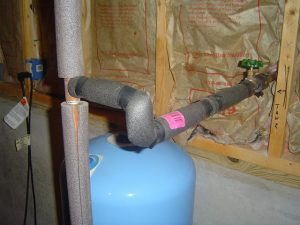Insulating Water Pipes is Easy to Do and Offers a Number of Advantages
By Mark J. Donovan
|
|
Insulating plumbing water pipes offers several advantages. During winter months, where basements and crawl spaces can be cool, insulating water pipes prevents hot water pipes from loosing heat. In addition, during winter months in unheated basement and attic crawl spaces, insulating plumbing water pipes prevents pipes from outright freezing and bursting. Insulating plumbing water pipes also helps during the summer months, particularly with cold water plumbing supply lines. Pipe insulation prevents cold water pipes from sweating during hot and humid summer days.
Insulating plumbing water pipes is very easy to do. There are a number of water pipe insulation products that you can find at any home improvement center. |
The easiest to install and cheapest water pipe insulation product available on the market today is pre-split polyethylene insulation. To install it cut it to the desired length, spread it at its seam and slide it over the water pipes. Finally peel back the protective paper covering at the slit and then just gently press the edges together to get a tight seal. When installing over corners, it is best to use two pieces. Cut each abutting end of pipe insulation at 45 degree angles before installing. The result between the two pieces when installed will be a nice 90 degree corner.
| With all seams, however, you’ll want to use reinforced foam insulating tape to ensure tightly insulated seams. Wrap the seams by spinning the tape around each bend making sure to create overlapping spirals in the process.
Fiberglass insulation jackets is another insulation water pipe product type that works well for insulating plumbing water pipes. It is a bit more difficult to work with and has a firmer surface. Consequently this type of water pipe insulation is usually limited to long straight stretches of water pipes. |
 |
They too have slits where the insulation can be slid over the water pipes. They are also self adhesive and work the same way as the polyethylene foam insulation. In addition, their surface can be painted, which is an important attribute if you are going for that industrial ceiling look in a finished basement.
A slightly more expensive water pipe insulation type that provides an even better insulation R-value is elastomeric thermal pipe insulation. It has a working temperature range of -297 degrees (F) to +220 degrees (F) making it ideal for both preventing heat loss and condensation problems.
It is commonly used in air conditioning applications. Some types can also protect against mold and mildew growth.
For information on installing a shower pan membrane liner for a ceramic tile shower, see the Shower Pan Membrane Liner Installation eBook from HomeAdditionPlus.com. The Shower Pan Membrane Liner EBook will quickly teach you the step-by-step process for installing the shower pan membrane liner correctly. It includes instructions on framing the shower stall, pouring the pre-slope and shower base mortar, and installing the shower pan membrane liner.
For information on how to tile a custom ceramic tile shower, see the “How to Tile a Custom Ceramic Tile Shower eBook” from HomeAdditionPlus.com. This eBook will quickly provide you with step-by-step instructions on how to measure and install ceramic tile in a shower, including the installation of tile on shower walls, floors and curbs. It provides detailed instructions for every step in the process of tiling a custom ceramic tile shower and is loaded with instructional pictures!
Related Information
Additional Plumbing Resources from Amazon.com
 |
 |
Get Free Bathroom Remodeling Price Quotes with No Obligation!
Fill out our 3-5 minute quick and easy form, and receive a free price quote on a bathroom remodeling project from one of our pre-screened and licensed bathroom remodeling contractors. This process is free and there is no obligation to continue once you receive your bathroom addition price estimate.
